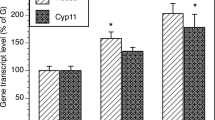Abstract
Recently, cadmium has been described to disturb ovarian function in rats. In this paper the direct influence of cadmium on steroid production of ovarian cellsin vitro has been studied. Granulosa and luteal cells were obtained from proestrous and pregnant rats, and incubated with 0, 5, 10, 20 or 40 μg ml−1 CdCl2 in the presence or absence of 0.1–1000 ng ml−1 follicle stimulating hormone (FSH) or luteinizing hormone (LH) for 24 or 48 h. Production of progesterone (P) and 17β-estradiol (E2) by granulosa and that of P by luteal cells were measured by radioimmunoassay. In FSH-stimulated granulosa cell cultures, 5 and 40 μg ml−1 CdCl2 suppressed P accumulation to 65 and 10%, respectively; accumulation of E2 (at 5 μg ml−1 CdCl2) decreased to 44%. P production of LH-supported luteal cells dropped to 86 and 66%, respectively, when 5 and 40 μg ml−1 CdCl2 was added to the medium. No alteration in basal P accumulation occurred in granulosa and luteal cell cultures following incubations with 20 and 40 μg ml−1 CdCl2, whereas basal E2 production of granulosa cells was markedly diminished. It is concluded that CdCl2 suppressing steroid synthesisin vitro exerts a direct influence on granulosa and luteal cell function.
Similar content being viewed by others
References
Akiyama K, Sufoo D, Reid DG. 1990 A1H-NMR comparison of calmodulin activation by calcium and cadmium.Jpn J Pharmacol,53, 393–401.
Amsterdam A, Rotmensch S. 1987 Structure-function relationship during granulosa cell differentiation.Endocrine Rev 8, 309–337.
Dencker L. 1975 Possible mechanism of cadmium fetotoxicity in Golden hamsters and mice: uptake by the embryo, placenta and ovary.J Reprod Fertil 44, 461–71.
Fortune JE, Hilbert JL. 1986 Estardiol secretion by granulosa cells from rats with four- or five-day estrous cycles: the development of responses to follicle-stimulating hormoneversus luteinizing hormone.Endocrinology 118, 2395–2401.
Gosden RG, Hunter RHF, Telfer E, Torrance C, Brown N. 1988 Physiological factors underlying the formation of ovarian follicular fluid.J Reprod Fertil 82, 813–825.
Hansel W, Dowd JP. 1986 New concepts of the control of corpus luteum function.J Reprod Fertil 78, 755–768.
Hinkle, PM, Kinsella PA, Osterhoudt KC. 1987 Cadmium uptake and toxicity via voltage-sensitive calcium channels.J Biol Chem 262, 16333–16337.
Janson PO, Dambar JE, Axen C. 1981 Luteal blood flow and progesterone secretion in pseudopregnant rabbits.J Reprod Fertil 63, 491–497.
Klug S, Planas-Bohne F, Taylor DM. 1988 Factors influencing the uptake of cadmium into cellsin vitro.Human Toxicol 7, 545–549.
Koizumi T, Waalkes MP. 1989 Effects of zinc on the distribution and toxicity of cadmium in isolated interstitial cells of the rat testis.Toxicology 56, 137–146.
Morris B, Sass MB. 1966 The formation of lymph in the ovary.Proc Soc London B 164, 577–591.
Nimura E, Miura K, Shinobu LA, Imura N. 1987 Enhancement of Ca2+-sensitive myosin ATPase activity by cadmium.Ecotoxicol Environ Safety 14, 184–189.
Orly J, Sato G, Erickson GF. 1980 Serum suppresses the expression of hormonally induced functions in cultured granulosa cells.Cell 20, 817–827.
Paksy K, Varga B, Horváth E, Tátrai E, Ungváry Gy. 1989 Acute effects of cadmium on preovulatory serum FSH, LH, and prolactin levels and on ovulation and ovarian hormone secretion in estrous rats.Reprod Toxicol 3, 241–247.
Paksy K, Náray M, Varga B, Kiss I, Folly G, Ungváry Gy. 1990a Uptake and distribution of Cd in the ovaries, adrenals, and pituitary in pseudopregnant rats: effect of Cd on progesterone serum levels.Environ Res 51, 83–90.
Paksy K, Varga B, Folly G. 1990b Long term effects of a single cadmium chloride injection on the ovulation, ovarian progesterone and estradiol-17β secretion in rats.Acta Physiol Hung 76, 245–252.
Perrino BA, Chou I-N. 1986. Role of calmodulin in cadmium-induced microtubule disassembly.Cell Biol Int Rep 10, 565–573.
Scheuhammer AM, Onosaka S, Rodgers K, Cherian MG. 1985 The interaction of zinc and cadmium in the synthesis of hepatic metallothionein in rats.Toxicology 36, 101–108.
Setchell BP. 1978 Naturally occurring and induced dysfunction of the testis. In Setchell PB, ed.The Mammalian Testis London: ELEK; 393–410.
Smith JB, Dwyer SD, Smith L. 1989 Cadmium evokes inositol polyphosphate formation and calcium mobilization.J Biol Chem 264, 7115–7118.
Sumi Y, Suzuki T, Suzuki KT. 1987 Autoradiographic demonstration of cadmium not bound to metallothionein using14C-labeled thiazolo-naphtol.Histochemistry 87, 327–329.
Suzuki KT, Sunaga H, Kobayashi E, Shimajo N. 1986 Mercaptalbumin as a selective cadmium binding protein in rat serum.Toxicol Appl Pharmacol 86, 466–473.
Varga B, Horváth E, Folly G, Stark E. 1985 Study of the luteinizing hormone-induced increase of ovarian blood flow during the estrous cycle in the rat.Biol Reprod 32, 480–488.
Varga B, Paksy K. 1991 Toxic effects of cadmium on LHRH-induced LH release and ovulation in rats.Reprod Toxicol 5, 199–203.
Veldhuis JD, Klase PA, Demers LM, Chafouleas JG. 1984 Mechanisms subserving calcium's modulation of luteinizing hormone action in isolated swine granulosa cells.Endocrinology 114, 441–449.
Waalkes MP, Perantoni A, Palmer AE. 1988a Isolation and partial characterization of the low-molecular-mass zinc/cadmium-binding protein from the testes of the patas monkey (Erythrocebus patas). Distinction from metallothionein.Biochem J 256, 131–137.
Waalkes MP, Rehm S, Perantoni A. 1988b Metal-binding proteins of the Syrian hamster ovaries: apparent deficiency of metallothionein.Biol Reprod 39, 953–961.
Zsolnai B, Varga, B, Paksy K, Náray M, Hamar O, Weidinger H. 1992 Die Akkumulation von Cadmium in menschlichen Ovarien und in der Placenta. In: Weidinger H, ed.Bioelemente und Schwangerschaft Berlin: Münchner Wissenschaftliche Publikationen, Blackwell Wissenschaft.
Author information
Authors and Affiliations
Rights and permissions
About this article
Cite this article
Paksy, K., Varga, B. & Lázár, P. Cadmium interferes with steroid biosynthesis in rat granulosa and luteal cellsin vitro . Biometals 5, 245–250 (1992). https://doi.org/10.1007/BF01061225
Received:
Accepted:
Issue Date:
DOI: https://doi.org/10.1007/BF01061225




